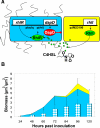Self-organization, layered structure, and aggregation enhance persistence of a synthetic biofilm consortium
- PMID: 21347422
- PMCID: PMC3036657
- DOI: 10.1371/journal.pone.0016791
Self-organization, layered structure, and aggregation enhance persistence of a synthetic biofilm consortium
Abstract
Microbial consortia constitute a majority of the earth's biomass, but little is known about how these cooperating communities persist despite competition among community members. Theory suggests that non-random spatial structures contribute to the persistence of mixed communities; when particular structures form, they may provide associated community members with a growth advantage over unassociated members. If true, this has implications for the rise and persistence of multi-cellular organisms. However, this theory is difficult to study because we rarely observe initial instances of non-random physical structure in natural populations. Using two engineered strains of Escherichia coli that constitute a synthetic symbiotic microbial consortium, we fortuitously observed such spatial self-organization. This consortium forms a biofilm and, after several days, adopts a defined layered structure that is associated with two unexpected, measurable growth advantages. First, the consortium cannot successfully colonize a new, downstream environment until it self-organizes in the initial environment; in other words, the structure enhances the ability of the consortium to survive environmental disruptions. Second, when the layered structure forms in downstream environments the consortium accumulates significantly more biomass than it did in the initial environment; in other words, the structure enhances the global productivity of the consortium. We also observed that the layered structure only assembles in downstream environments that are colonized by aggregates from a previous, structured community. These results demonstrate roles for self-organization and aggregation in persistence of multi-cellular communities, and also illustrate a role for the techniques of synthetic biology in elucidating fundamental biological principles.
Conflict of interest statement
Figures


References
-
- Shapiro JA. Thinking about bacterial populations as multicellular organisms. Annu Rev Microb. 1998;52:81–104. - PubMed
-
- Johnson CR, Boerlijst MC. Selection at the level of the community: The importance of spatial structure. Trends Ecol Evol. 2002;17:83–90.
-
- West SA, Pen I, Griffin AS. Conflict and cooperation - cooperation and competition between relatives. Science. 2002;296:72–75. - PubMed
-
- West SA, Griffin AS, Gardner A, Diggle SP. Social evolution theory for microorganisms. Nat Rev Microbiol. 2006;4:597–607. - PubMed
-
- Lion S, van Baalen M. Self-structuring in spatial evolutionary ecology. Ecol Lett. 2008;11:277–295. - PubMed
Publication types
MeSH terms
Grants and funding
LinkOut - more resources
Full Text Sources

